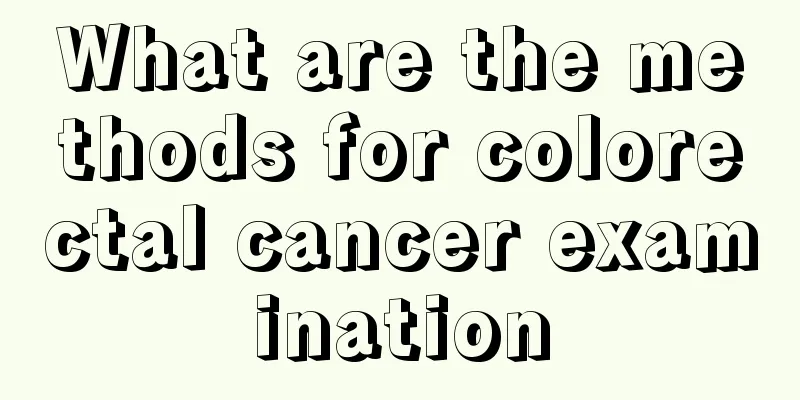What are the methods for colorectal cancer examination

|
With the improvement of living standards, the quality of life has also been greatly improved. Many people choose high-calorie, high-fat foods. For young people, crude fiber and coarse grains seem to have withdrawn from people's lives, which has led to the occurrence of various diseases, colorectal cancer being one of them. For colorectal cancer with a very high incidence rate, what are the methods for colorectal cancer examination? Let us introduce them to you in detail. 1. Laboratory examination Blood routine, complete biochemistry (liver and kidney function + serum iron), stool routine + fecal occult blood and other laboratory tests can help understand whether the patient has iron deficiency anemia, liver and kidney function and other basic conditions. Testing for blood tumor marker carcinoembryonic antigen (CEA) can help diagnose tumors. In patients with colorectal cancer, high CEA levels do not mean that there is distant metastasis; in a few patients with metastatic tumors, CEA levels are not elevated. 2. Endoscopic examination Colonoscopy is to insert a fiber colonoscope into the ileocecal region at the beginning of the colon to examine the colon and rectal cavities, and perform biopsies and treatments during the examination. Colonoscopy is more accurate than barium enema X-rays, especially for small colon polyps, which can be removed by colonoscopy and confirmed by pathology. Removal of benign polyps can prevent them from turning into colorectal cancer, and cancerous polyps can help clarify the diagnosis and treatment. 3. Biopsy and exfoliative cytology Biopsy is of decisive significance for the diagnosis of colorectal cancer, especially early cancer and polyp cancer, as well as for differential diagnosis of lesions. It can clarify the nature, histological type and malignancy of the tumor, judge the prognosis and guide clinical treatment. Exfoliative cytology has high accuracy, but the sampling is cumbersome, and it is not easy to obtain satisfactory specimens, so it is rarely used in clinical practice. Colorectal cancer must be differentiated from other intestinal lesions with symptoms such as abdominal mass, abdominal cramps, rectal bleeding or changes in bowel habits, including benign tumors or polyps of the colon such as adenoma, inflammatory polyps, juvenile polyps, intestinal wall lipoma, hemangioma, leiomyoma, etc.; various inflammatory diseases of the colon such as ulcerative colitis, Crohn's disease, amoebic enteritis, Japanese schistosomiasis, intestinal tuberculosis, colon diverticulitis, inflammatory masses around appendicitis, radiation enteritis, venereal lymphogranuloma, etc., benign rectal and anal canal diseases such as hemorrhoids, anal fissures, anal fistulas, etc. Others such as intussusception, sigmoid colon fecal mass storage and rare intestinal endometriosis are also included in the differentiation. Since the symptoms of colorectal cancer are not specific and overlap with the clinical manifestations of various intestinal diseases, active diagnosis is often used in clinical diagnosis, and exclusion diagnosis is rarely used. For suspected patients, detailed medical history is inquired and careful examination is performed, and a clear diagnosis can often be made with fiber colonoscopy or X-ray barium meal enema and pathological biopsy. Colon cancer should be mainly differentiated from colon inflammatory diseases, including intestinal tuberculosis, Crohn's disease, ulcerative colitis, schistosomiasis granuloma, amebiasis granuloma, etc. In addition, it should be differentiated from primary liver cancer, biliary tract disease, and appendix abscess. Rectal cancer should be differentiated from bacillary dysentery, amoebic dysentery, hemorrhoids, schistosomiasis, chronic colitis, etc. Through the above introduction, we have learned about the examination of colorectal cancer and how to make a differential diagnosis. I hope that friends can understand their own physical changes through learning, and choose the appropriate examination method according to the severity of their condition. Colorectal cancer is one of the malignant tumors, which brings great physical harm to patients. Therefore, friends in life must develop good eating habits, which can also effectively reduce the occurrence of colorectal cancer. |
<<: Is bladder cancer contagious through urine?
>>: Can colorectal ultrasound detect colorectal cancer?
Recommend
The correct posture for sit-ups
Nowadays, many people have a high pursuit of beau...
Is it necessary to beautify the grout of floor tiles?
When building a house, the issue of laying floor ...
What causes a cold scalp? Is it serious?
There are many reasons for a cold scalp, such as ...
High ferritin
Ferritin is a protein that stores iron. Its conte...
What are the benefits of eating cold jellyfish?
Jellyfish has many functions. For example, in sum...
How many days after wisdom teeth extraction can I brush my teeth?
When you go to check your teeth normally, if this...
What medicine to use for blood in stool
If there is blood in the stool, it means that the...
How to clean a pacifier
A pacifier is something that is designed to imita...
What should I do if my shoulders get cold during confinement?
Generally, women are very weak and have weak resi...
Can I eat cherries while drinking red wine?
Red wine is a common type of wine in daily life, ...
How to prevent gastric cancer in daily diet
Gastric cancer is one of the common malignant tum...
What is the current situation of small cell lung cancer
Small cell lung cancer is a type of bronchial lun...
Medicine for growing endometrium
The endometrium is extremely important for women....
Why does my neck often get stiff?
Many people do not pay attention to stiff neck, w...
What are the causes of thyroid cancer?
What are the causes of thyroid cancer? Modern peo...









